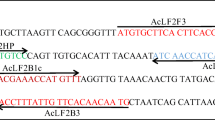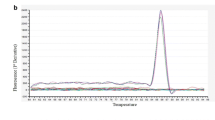Abstract
As a marine bacterial pathogen, Photobacterium damselae subsp. damselae (PDD) is distributed in seawater worldwide. It can infect different animals as well as humans, even cause deaths. The highly conserved regions of PDD mcp gene on chromosome and dly gene on plasmid were selected as the target fragments to design the specific primers. Recombinant plasmid standard was prepared based on the primers. With GENECHECKER UF-150 qRT-PCR instrument as the platform, a fluorescence-based quantitative real-time PCR (qRT-PCR) method was established for the detection of PDD. This method can specifically detect PDD and distinguish the highly virulent strains. Additionally, the test results can be qualitatively judged by visualization, while the quantitative detection can be achieved through the standard curve calculation. The minimum limit of detection was 1.0×101 copies µL−1, and the detection time was less than 20 min. In summary, this new method has outstanding advantages, such as strong specificity, high sensitivity, and low site requirements. It is a rapid on-site detection technology for highly virulent PDD strains.
Similar content being viewed by others
References
Alhemairi, M., Alghanmi, F., and Alshamrani, A. S., 2015. Child death due to infection with Photobacterium damselae subs. damselae, a new case. Journal of Medical Sciences, 23(3): 176–178.
Cheng, G., Hussain, T., Sabir, N., Ni, J., Li, M., Zhao, D., and Zhou, X., 2019. Comparative study of the molecular basis of pathogenicity of M. bovis strains in a mouse model. International Journal of Molecular Sciences, 20(1): 5.
Cole, J. R., Wang, Q., Cardenas, E., Fish, J., Chai, B., Farris, R. J., Kulam-Syed-Mohideen, A. S., McGarrell, D. M., Marsh, T., Garrity, G. M., and Tiedje, J. M., 2009. The ribosomal database project: Improved alignments and new tools for rRNA analysis. Nucleic Acids Research, 37(Sup 1): D141–D145.
Cutter, D. L., and Kreger, A. S., 1990. Cloning and expression of the damselysin gene from Vibrio damsela. Infection and Immunity, 58(1): 266–268.
De Paz, H. D., Brotons, P., and Muñoz-Almagro, C., 2014. Molecular isothermal techniques for combating infectious diseases: Towards low-cost point-of-care diagnostics. Expert Review of Molecular Diagnostics, 14(7): 827–843.
Fujioka, R. S., Greco, S. B., Cates, M. B., and Schroeder, J. P., 1988. Vibrio damsela from wounds in bottlenose dolphins Tursiops truncatus. Diseases of Aquatic Organisms, 4(1): 1–8.
Hanlon, R. T., Forsythe, J. W., Cooper, K. M., Dinuzzo, A. R., Folse, D. S., and Kelly, M. T., 1984. Fatal penetrating skin ulcers in laboratory-reared octopuses. Journal of Invertebrate Pathology, 44(1): 67–83.
Ketterer, P. J., and Eaves, L. E., 1992. Deaths in captive eels (Anguila reinhardtii) due to Photobacterium (Vibrio) damsela. Australian Veterinary Journal, 69(8): 203–204.
Kothary, M. H., and Kreger, A. S., 1985. Purification and characterization of an extracellular cytolysin produced by Vibrio damsela. Infection and Immunity, 49(1): 25–31.
Kreger, A. S., Bernheimer, A. W., Etkin, L. A., and Daniel, L. W., 1987. Phospholipase D activity of Vibrio damsela cytolysin and its interaction with sheep erythrocytes. Infection and Immunity, 55(12): 3209–3212.
Labella, A., Vida, M., Alonso, M. C., Infante, C., Cardenas, S., Lopez-Romalde, S., Manchado, M., and Borrego, J. J., 2006. First isolation of Photobacterium damselae ssp. damselae from cultured redbanded seabream, Pagrus auriga Valenciennes, in Spain. Journal of Fish Diseases, 29(3): 175–179.
Lee, K., Kim, H. K., Sohn, H., Cho, Y., Choi, Y. M., Jeong, D. G., and Kim, J. H., 2018. Genomic insights into Photobacterium damselae subsp. damselae strain KC-Na-1, isolated from the finless porpoise (Neophocaena asiaeorientalis). Marine Genomics, 37: 26–30.
Love, M., Teebken-Fisher, D., Hose, J. E., Farmer, J. J., Hickman, F. W., and Fanning, G. R., 1981. Vibrio damsela, a marine bacterium, causes skin ulcers on the damselfish Chromis punctipinnis. Science, 214(4525): 1139–1140.
Lozano-León, A., Osorio, C. R., Nuñez, S., Martínez-Urtaza, J., and Magariños, B., 2003. Occurrence of Photobacterium damselae subsp. damselae in bivavlve molluscs from Northwest Spain. Bulletin of the European Association of Fish Pathologists, 23(1): 40–44.
Luo, G., Xu, X., Zhao, L., Qin, Y., Huang, L., Su, Y., and Yan, Q., 2019. clpV is a key virulence gene during in vivo Pseudomonas plecoglossicida infection. Journal of Fish Diseases, 42(7): 991–1000.
Matanza, X. M., and Osorio, C. R., 2018. Transcriptome changes in response to temperature in the fish pathogen Photobacterium damselae subsp. damselae: Clues to understand the emergence of disease outbreaks at increased seawater temperatures. PLoS One, 13(12): e0210118.
Morris, J. G., Wilson, R., Hollis, D. G., Weaver, R. E., Miller, H. G., Tacket, C. O., Hickman, F. W., and Blake, P. A., 1982. Illness caused by Vibrio damsela and Vibrio hollisae. The Lancet, 319(8284): 1294–1297.
Obendorf, D. L., Carson, J., and McManus, T. J., 1987. Vibrio damsela infection in a stranded leatherback turtle (Dermochelys coriacea). Journal of Wildlife Diseases, 23(4): 666–668.
Park, S., Zhang, Y., Lin, S., Wang, T. H., and Yang, S., 2011. Advances in microfluidic PCR for point-of-care infectious disease diagnostics. Biotechnology Advances, 29(6): 830–839.
Pedersen, K., Dalsgaard, I., and Larsen, J. L., 1997. Vibrio damsela associated with diseased fish in Denmark. Applied and Environmental Microbiology, 63(9): 3711–3715.
Perez-Tirse, J., Levine, J. F., and Mecca, M., 1993. Vibrio damsela: A cause of fulminant septicemia. Archives of Internal Medicine, 153(15): 1838–1840.
Raymond, C. R., and Wilkie, B. N., 2004. Th-1/Th-2 type cytokine profiles of pig T-cells cultured with antigen-treated monocyte-derived dendritic cells. Vaccine, 22(8): 1016–1023.
Rivas, A. J., Balado, M., Lemos, M. L., and Osorio, C. R., 2011. The Photobacterium damselae subsp. damselae hemolysins damselysin and HlyA are encoded within a new virulence plasmid. Infection and Immunity, 79(11): 4617–4627.
Rivas, A. J., Balado, M., Lemos, M. L., and Osorio, C. R., 2013a. Synergistic and additive effects of chromosomal and plasmidencoded hemolysins contribute to hemolysis and virulence in Photobacterium damselae subsp. damselae. Infection and Immunity, 81(9): 3287–3299.
Rivas, A. J., Lemos, M. L., and Osorio, C. R., 2013b. Photobacterium damselae subsp. damselae, a bacterium pathogenic for marine animals and humans. Frontiers in Microbiology, 4: Article 283.
Rivas, A. J., Vences, A., Husmann, M., Lemos, M. L., and Osorio, C. R., 2015. Photobacterium damselae subsp. damselae major virulence factors Dly, plasmid-encoded HlyA, and chromosome-encoded HlyA are secreted via the Type II scretion system. Infection and Immunity, 83(4): 1246–1256.
Rivas, A. J., Von Hoven, G., Neukirch, C., Meyenburg, M., Qin, Q., Füser, S., Boller, K., Lemos, M. L., Osorio, C. R., and Husmann, M., 2015. Phobalysin, a small β-pore-forming toxin of Photobacterium damselae subsp. damselae. Infection and Immunity, 83(11): 4335–4348.
Saroj, S. D., Shashidhar, R., Karani, M., and Bandekar, J. R., 2008. Distribution of Salmonella pathogenicity island (SPI)-8 and SPI-10 among different serotypes of Salmonella. Journal of Medical Microbiology, 57(4): 424–427.
Shi, L. N., Yu, Y. X., Jiang, Y., Zhang, Z., Wang, Y. G., Liao, M. J., and Rong, X. J., 2019. Studies on the phenotypic differences of different Photobacterium damselae subsp. damselae strains. Marine Sciences, 43(6): 15–24 (in Chinese with English abstract).
Song, Y. L., Cheng, W., and Wang, C. H., 1993. Isolation and characterization of Vibrio damsela, infectious for cultured shrimp in Taiwan. Journal of Invertebrate Pathology, 61(1): 24–31.
Sun, Y., Zhuang, Z., Wang, X., Huang, H., Fu, Q., and Yan, Q., 2019. Dual RNA-seq reveals the effect of flgM gene of Pseudomonas plecoglossicida on immune response of Epinephelus coioides. Fish & Shellfish Immunology, 87: 515–523.
Takahashi, H., Miya, S., Kimura, B., Yamane, K., Arakawa, Y., and Fujii, T., 2008. Difference of genotypic and phenotypic characteristics and pathogenicity potential of Photobacterium damselae subsp. damselae between clinical and environmental isolates from Japan. Microbial Pathogenesis, 45(2): 50–158.
Terceti, M. S., Ogut, H., and Osorio, C. R., 2016. Photobacterium damselae subsp. damselae, an emerging fish pathogen in the Black Sea: Evidence of a multiclonal origin. Applied and Environmental Microbiology, 82(13): 3736–3745.
Terceti, M. S., Vences, A., Matanza, X. M., Dalsgaard, I., Pedersen, K., and Osorio, C. R., 2018. Molecular epidemiology of Photobacterium damselae subsp. damselae outbreaks in marine rainbow trout farms reveals extensive horizontal gene transfer and high genetic diversity. Frontiers in Microbiology, 9: Article 2155.
The, C. S. J., Chua, K. H., and Thong, K. L., 2010. Simultaneous differential detection of human pathogenic and nonpathogenic Vibrio species using a multiplex PCR based on gyrB and pntA genes. Journal of Applied Microbiology, 108(6): 1940–1945.
Ud-Din, A. I. M. S., and Roujeinikova, A., 2017. Methyl-accepting chemotaxis proteins: A core sensing element in prokaryotes and archaea. Cellular and Molecular Life Sciences, 74(18): 3293–3303.
Vaseeharan, B., Sundararaj, S., Murugan, T., and Chen, J. C., 2007. Photobacterium damselae ssp. damselae associated with diseased black tiger shrimp Penaeus monodon Fabricius in India. Letters in Applied Microbiology, 45(1): 82–86.
Vences, A., Rivas, A. J., Lemos, M. L., Husmann, M., and Osorioa, C. R., 2017. Chromosome-encoded hemolysin, phospholipase, and collagenase in plasmidless isolates of Photobacterium damselae subsp. damselae contribute to virulence for fish. Applied and Environmental Microbiology, 83(11): e00401–17.
Wen, W. Y., Xie, Z. Y., Xu, X. D., Zhang, X. Z., Zhang, S. X., and Zhou, Y. C., 2009. Establishment of a rapid PCR detection method for Vibrio fluvialis based on toxR gene. Fisheries Science, 28(10): 575–578 (in Chinese with English abstract).
Yamane, K., Asato, J., Kawade, N., Takahashi, H., Kimura, B., and Arakawa, Y., 2004. Two cases of fatal necrotizing fasciitis caused by Photobacterium damsela in Japan. Journal of Clinical Microbiology, 42(3): 1370–1372.
Yan, N., Zhang, Z. Q., Wu, T. L., Zhu, J. X., Fu, Y. F., Han, H. S., Wang, H. B., Shi, Q. M., and Gao, G. S., 2018. Isolation and identification of Photobacterium damselae subsp. damselae (PDD) from Tongue Sole. Animal Husbandry and Feed Science, 10(2): 99–114.
Yu, Y. X., Zhang, Z., Wang, Y. G., Liao, M. J., Rong, X. J., Li, B., Wang, K., Chen, J., and Zhang, H., 2019. Complete genome sequence of Photobacterium damselae subsp. damselae strain SSPD1601 isolated from deep-sea cage-cultured Sebastes schlegelii with septic skin ulcer. International Journal of Genomics, 2019: Article 4242653.
Yuen, K. Y., Ma, L., Wong, S. S. Y., and Ng, W. F., 1993. Fatal necrotizing fasciitis due to Vibrio damsel. Scandinavian Journal of Infectious Diseases, 25(5): 659–661.
Zhang, X. J., Qin, G. M., Chen, C. Z., Fang, G., and Yan, B. L., 2009. Biological characterization and phylogenetic analysis of Photobacterium damselae subsp. damselae from diseased Epinephelus lanceolatus L. Progress in Fishery Science, 30(3): 38–43 (in Chinese with English abstract).
Zhang, Z., Yu, Y. X., Jiang, Y., Wang, Y. G., Liao, M. J., Rong, X. J., Wang, K., Zhang, H., and Chen, J., 2019a. First report of isolation and complete genome of Vibrio rotiferianus strain SSVR1601 from cage-cultured black rockfish (Sebastes schlegelii) associated with skin ulcer. Journal of Fish Diseases, 42(5): 623–630.
Zhang, Z., Yu, Y. X., Wang, K., Wang, Y. G., Jiang, Y., Liao, M. J., and Rong, X. J., 2019b. First report of skin ulceration caused by Photobacterium damselae subsp. damselae in net-cage cultured black rockfish (Sebastes schlegeli). Aquaculture, 503: 1–7.
Acknowledgements
This work was supported by the National Key Research and Development Program of China (No. 2019YFD0900 104), and the Key Projects of Science and Technology Innovation of Shandong Province (No. 2018YFJH0703).
Author information
Authors and Affiliations
Corresponding author
Rights and permissions
About this article
Cite this article
Zhang, Z., Yu, Y., Chen, J. et al. Development of a Microfluidics-Based Quantitative Real-Time PCR to Rapidly Identify Photobacterium damselae subsp. damselae with Different Pathogenicity by Detecting the Presence of mcp or dly Gene. J. Ocean Univ. China 20, 445–453 (2021). https://doi.org/10.1007/s11802-021-4544-3
Received:
Revised:
Accepted:
Published:
Issue Date:
DOI: https://doi.org/10.1007/s11802-021-4544-3




